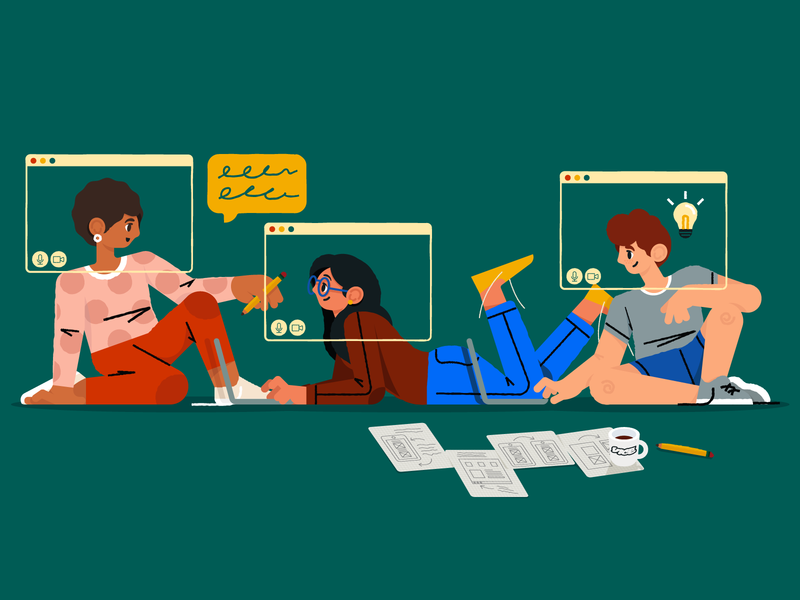This post was written by Arman Nobari, creator of Sharpen.design. Read further to learn what makes a designer “senior” level, how to attain this kind of role, and what it all means in the context of working remotely.
Early in my career, I saw the path before me as linear. “Just do really good design work and I’ll be on the path to a senior role”, I thought. I didn’t even know what a senior role meant at the time, just that it was further along in a career than where I was. In retrospect, my eagerness to prove myself caused me to focus on the wrong things early on. As a Senior Product Designer with experience ranging from Google, to all sizes of startups, and freelancing, I’m here to save you from a similar headache.
In this article, I’ll unpack the concept of seniority contextually; either general things I’ve noticed as a consistent truth at both large and small companies, or specific contexts in which something is more valuable than others. This article contains the advice I wish I had a decade ago, along with some additional notes about what seniority means while working remotely.
📌 RELATED — What is a Design Lead?
Generally, what makes a designer “senior”?
Attaining seniority isn’t just a title—it’s inherently a stage of your career when you choose to think beyond yourself, and actively think about lifting up others. While more can certainly go into creating the archetypal senior designer, I’ve found that it boils down to being exemplary in 4 areas: Craft, Empathy, Ethics, and Leadership.
Craft
There’s no getting around this one, but it’s deeper than just being able to produce really good designs. Craft is holistic. It includes valuing research, taking critique well, giving constructive and considerate critiques to others, thinking beyond your narrow area of work, and considering how your designs impact the larger team, organization, and company. Things like systemic thinking, proactively seeking feedback, articulation of your decisions, balancing business and any engineering goals with your work, and using data in the best interest of the user are all hallmarks of strong craft beyond the actual production of designs.
If you’re not finding opportunities to challenge yourself in your current role, it’s worth practicing in your own spare time. Side-projects are absolutely valid to show in substantiating a promotion or role change, so make the most of your time! If you don’t know what to practice designing, I made a free tool to help you generate practice-project ideas called Sharpen.
Empathy
If other people experience the end result of your design work, you have to be empathetic. It doesn’t matter if you’re doing graphic design, mobile UX, or any other form of design, you must consider the living being on the other end of your work. This includes users, your teammates, and even your competitors. Your work is ultimately in service of their needs, goals, and problems, and you should advocate for them to be more seen, heard, and valued.
Ethics
Appreciating and advocating for research, data, transparency in decision-making, and fairness is of paramount importance. As is the steadfast defense against unethical courses of action that would compromise dedication to ethical principles. You look out for others, not because you’ll get to tell them that you did, but because it’s the right thing to do. Your decisions help ensure the culture around you continually lifts others up, and doesn’t create gatekeepers.
Leadership
Craft, Empathy, and Ethics together in action creates a lens to see opportunities to solve problems. Seniority implies you don’t wait for work to be “assigned” to you, but instead, you actively seek ways to positively impact projects. You don’t need to be hand-held, and your strong principles as a designer ensure you work effectively alone, in teams, and when lending a hand.
Seniority is earned, not a benchmark to hit
Attaining a senior role is so much more than hitting a checklist of requirements to “prove” you deserve it. It is fundamentally about trust, and in many cases, that has to be earned through consistency and impact.
While it might bruise an ego on the surface, consider the context. Senior designers are generally given more autonomy and responsibility, which means an unqualified person who “gets” a senior title instead of earning one can wreak havoc.
Even if you think you’re senior-level material, you have to build that trust and empathize with others. Seeking a vanity title because you think it’s good for your career, or because you think it’ll cure imposter syndrome, are both naive things to strive for as well, since failing at a senior role is a strong indication you’re not ready for that next step. Trying to sneak into seniority will absolutely do more harm than good.
Seniority at smaller companies
With tighter teams, it might be easier to quickly build up trust at a smaller company. It’s presumed there’s less room to hide since you’re likely working one-on-one with leadership more often. You’re able to attune your work to the culture in which you’re operating, to the business goals, and to quickly-changing markets. You’re likely closer to the problems at hand, the users, and other teams.
This puts you in a great position to have a positive impact on others, both inside and outside the company. Your advocacy has to compete with less noise, and at the end of the day, there are likely fewer hoops to jump through to access leadership with new ideas for projects.
My first job out of college, with a communication degree, was being the second designer at a company called Whistle. They made IoT products for pets, and my craft was all over the place at first. But over time, I learned what the business valued, the specific contexts in which they needed help, and I sought opportunities to expand what I worked on. By the time the company was preparing for acquisition, I was promoted to a senior role, largely for going outside of my initial job description to help other teams with projects, for creating new ways to work with our engineers, and even helping the co-founders with their pitch decks. As I’ll go into in the next section, however, that senior title didn’t immediately transfer outside of Whistle; for all the right reasons.
Seniority at larger companies
After I felt I had grown all I could at Whistle, I accepted a full-time role at Google, working at YouTube. I quickly learned that seniority in one context didn’t automatically grant seniority in other places.
The difficulty in “transferring” seniority from place to place is that each company has their own ladder that determines what makes someone senior. I had one company under my belt, and just a few years of experience, so by Google’s standard I wasn’t “senior” right out of the gate.
Larger organizations have multiple layers of context that smaller companies simply don’t. Companies generally grow large either because of massive investment, healthy profits, or both. The financial context of working at a larger company can’t be overstated: you are there to help the business succeed, grow, and expand. Balancing business goals, striving for efficiency, and spotting opportunities to impact whole other teams, organizations, and divisions within a company can create a strong foundation to build up seniority atop.
It would be fair to wonder how as a junior designer at a larger company, you’d possibly impact beyond your immediate team, especially if your projects are smaller-scale, not user-facing, or otherwise not cross-functional. While every company is different, one truth remains: You need to ask for what you want.
If you’re able to maintain your current workload with high craft, ethics, and empathy, showing your leadership in spotting new problems to solve—or asking to help solve other problems—is a great way to build the trust needed to be regarded as senior.
Seniority when working remote
At the time of publishing this article, the world is rapidly adapting to a work-from-home shift, brought on by the coronavirus pandemic. With no one to physically look over your shoulder or chat in a hallway with when working from home, accountability is one of the most important qualities when assessing someone for a remote senior role.
The stress that teams are under is likely at record highs due to the uncertain futures of many markets, coupled with the personal health anxieties many of us are experiencing. Now more than ever, upholding the earnest responsibility to get the job done while working remotely can make or break whole teams. That accountability and honesty is how teams are going to make it through this time, and it is absolutely the capstone of a senior designer’s set of skills until—and likely far after—the world recovers from this.
Seniority is a mindset
First and foremost, don’t get caught up worrying about titles. There’s no shortcut to honing your skills, and having a senior title doesn’t somehow make you a better designer. There’s no way around it, you have to practice your core design craft, ethics, empathy, and leadership to earn seniority in an above-board sense. If you don’t see opportunities to grow any of those skills in your current context, it might be worth considering if that context is truly one you want to continue growing in.
Doing really, really good work is one part of the equation. But to truly advance to the senior stage of your career, you need to think about others much more than yourself. Being an example of ethical, responsible, and earnest conduct isn’t just a clear path to seniority; it’s the strongest possible foundation to build a lasting career in any field of design.
Especially in the uncertain times the world is currently facing, being authentically ready for the responsibility to proactively help others and lead design initiatives is more important than ever. Trying to sneak in a promotion to score a vanity title isn’t just detrimental to a business, but it can put the roles of others in jeopardy. You owe it to yourself with a career: play the long and honest game. After all, your future self will thank you for it.

![]() About the author: Arman Nobari is a self-taught product designer, developer, and portrait artist. He’s the co-founder of Sharpen.design, a research-backed practice design prompt generator.
About the author: Arman Nobari is a self-taught product designer, developer, and portrait artist. He’s the co-founder of Sharpen.design, a research-backed practice design prompt generator.
More career-building resources:
- 5 examples of unethical design interviews & how to navigate them
- The ultimate guide to hiring with design exercises
- 5 soft skills every Product Designer should master
Find more Community stories on our blog Courtside. Have a suggestion? Contact stories@dribbble.com.














